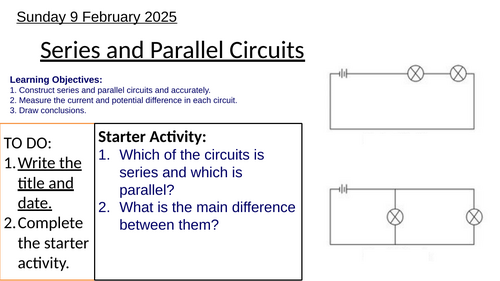
**Save 54% with the Complete Electricity Bundle! **
Get this lesson as part of our GCSE Electricity Bundle and enjoy a huge discount! Instead of buying lessons individually, grab the entire unit with 13 lessons, including required practicals, for just ÂŁ12.00.
Click here to get the bundle now: /teaching-resource/resource-13199110
This “Voltage & Current in Series and Parallel Circuits” PowerPoint lesson is designed for AQA GCSE Physics students, covering the key differences between series and parallel circuits, how current and voltage behave in each, and how to construct and measure circuits accurately. This resource aligns with the AQA GCSE specification and includes interactive simulations, circuit diagrams, and practical tasks.
Key Learning Objectives:
- Construct series and parallel circuits accurately using correct circuit symbols.
- Measure and compare current and voltage in both series and parallel circuits.
- Analyze brightness changes in bulbs when components are added to series and parallel circuits.
Lesson Features:
The lesson begins with a starter activity, where students identify series and parallel circuits and discuss their main differences.
Core Topics Covered:
What is a Series Circuit?
One continuous pathway for current to flow.
When more bulbs are added, brightness decreases due to increased resistance.
Current remains the same throughout the circuit.
What is a Parallel Circuit?
Two or more pathways for current to flow.
Adding more bulbs does not affect brightness.
Current splits across branches, but voltage remains the same.
Building and Measuring Circuits:
Students draw circuit diagrams for series and parallel circuits with different components.
Use PhET simulations or real equipment to observe current and voltage behaviors.
Current and Voltage Rules:
Series Circuits: Current is the same everywhere; voltage is shared between components.
Parallel Circuits: Current splits across branches; voltage remains the same across each branch.
Ammeter & Voltmeter Use: Instructions on correctly connecting meters in a circuit.
Interactive Activities:
âś” Build circuits using PhET simulations (linked in the lesson) or practical lab equipment.
âś” Draw and analyze circuit diagrams for different configurations.
âś” Complete calculations and observations for current and voltage measurements.
âś” Answer circuit-related problem-solving questions based on GCSE-style exam questions.
Lesson Summary & Plenary:
The lesson concludes with a reflection activity where students answer key questions, such as:
What happens to bulb brightness when more are added to a series circuit?
What happens if a bulb in a parallel circuit breaks?
File Details:
Format: Editable PowerPoint (.pptx)
Updated: February 2025
Aligned with: AQA GCSE Physics Specification
This resource provides clear explanations, real-world applications, and engaging activities, making it an essential lesson for series and parallel circuits in GCSE Physics.
Something went wrong, please try again later.
I hate teaching electricity usually, but this resource made it easy to teach the lesson.
to let us know if it violates our terms and conditions.
Our customer service team will review your report and will be in touch.
